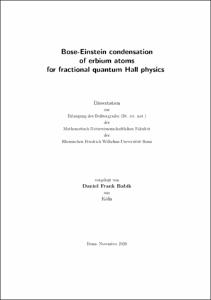Bose-Einstein condensation of erbium atoms for fractional quantum Hall physics

Bose-Einstein condensation of erbium atoms for fractional quantum Hall physics

| dc.contributor.advisor | Weitz, Martin | |
| dc.contributor.author | Babik, Daniel Frank | |
| dc.date.accessioned | 2021-04-21T10:40:09Z | |
| dc.date.available | 2021-04-21T10:40:09Z | |
| dc.date.issued | 21.04.2021 | |
| dc.identifier.uri | https://hdl.handle.net/20.500.11811/9046 | |
| dc.description.abstract | With the advent of ultracold atomic gases experimentally realized by laser cooling techniques nearly 40 years ago, the doors to accessing novel physical behaviour have been opened wide and far. Experimentally, research in this domain started with alkali atoms, proceeded with alkaline earth atoms, and only more recently embarked on atoms with higher complexity of their spectrum, as e.g. the highly dipolar lanthanide atomic species erbium and dysprosium. Those elements possess a non-vanishing orbital angular momentum in the ground state, leading to ample advantages for the manipulation with far-detuned laser light in phase imprinting schemes, as losses due to spontaneous scattering can be suppressed radically in comparison to the case of alkali atomic species. This beneficial behaviour will be used in the future for the generation of synthetic magnetic fields for electrically neutral erbium atoms aimed at investigating fractional quantum Hall physics. This thesis describes in the first part the generation of an atomic erbium Bose-Einstein condensate in a hybrid crossed optical dipole trap. The main purpose of this endeavor was an enhancement of absolute atom number of the degenerate ensemble and long-term stability of the experimental setup with respect to the use of a single beam dipole trap. A comparison of the here achieved results with respect to those achieved in only a single CO2 laser beam dipole trap is illustrated. In the second part of this thesis a theoretical evaluation of the generation of synthetic magnetic fields for ultracold erbium atoms in prospect for experimental investigations of fractional quantum Hall physics is presented. One of the most promising techniques for the realization of strong synthetic magnetic fields is by phase imprinting via Raman manipulation. Here for the theoretical calculation of such fields with erbium atoms a compared to earlier work on alkali atoms new modified optical Raman coupling scheme in a σ+ - σ- beam polarization configuration is chosen. It is shown that sufficiently high field strengths with good spatial homogeneity can be reached for experimentally viable parameters. Additionally, an estimation for the expected Laughlin gap in the proposed erbium atomic fractional quantum Hall system is given. | en |
| dc.language.iso | eng | |
| dc.rights | In Copyright | |
| dc.rights.uri | http://rightsstatements.org/vocab/InC/1.0/ | |
| dc.subject | Bose-Einstein-Kondensation | |
| dc.subject | Erbium | |
| dc.subject | Synthetische magnetische Felder | |
| dc.subject | Laughlin-Gap | |
| dc.subject | Bose-Einstein condensation | |
| dc.subject | phase-imprinting | |
| dc.subject | Raman manipulation | |
| dc.subject | synthetic magnetic fields | |
| dc.subject | artificial gauge fields | |
| dc.subject.ddc | 530 Physik | |
| dc.title | Bose-Einstein condensation of erbium atoms for fractional quantum Hall physics | |
| dc.type | Dissertation oder Habilitation | |
| dc.publisher.name | Universitäts- und Landesbibliothek Bonn | |
| dc.publisher.location | Bonn | |
| dc.rights.accessRights | openAccess | |
| dc.identifier.urn | https://nbn-resolving.org/urn:nbn:de:hbz:5-61758 | |
| ulbbn.pubtype | Erstveröffentlichung | |
| ulbbnediss.affiliation.name | Rheinische Friedrich-Wilhelms-Universität Bonn | |
| ulbbnediss.affiliation.location | Bonn | |
| ulbbnediss.thesis.level | Dissertation | |
| ulbbnediss.dissID | 6175 | |
| ulbbnediss.date.accepted | 22.02.2021 | |
| ulbbnediss.institute | Mathematisch-Naturwissenschaftliche Fakultät : Fachgruppe Physik/Astronomie / Institut für angewandte Physik (IAP) | |
| ulbbnediss.fakultaet | Mathematisch-Naturwissenschaftliche Fakultät | |
| dc.contributor.coReferee | Stellmer, Simon | |
| ulbbnediss.contributor.gnd | 123526565X |
Dateien zu dieser Ressource
Das Dokument erscheint in:
-
E-Dissertationen (4337)




